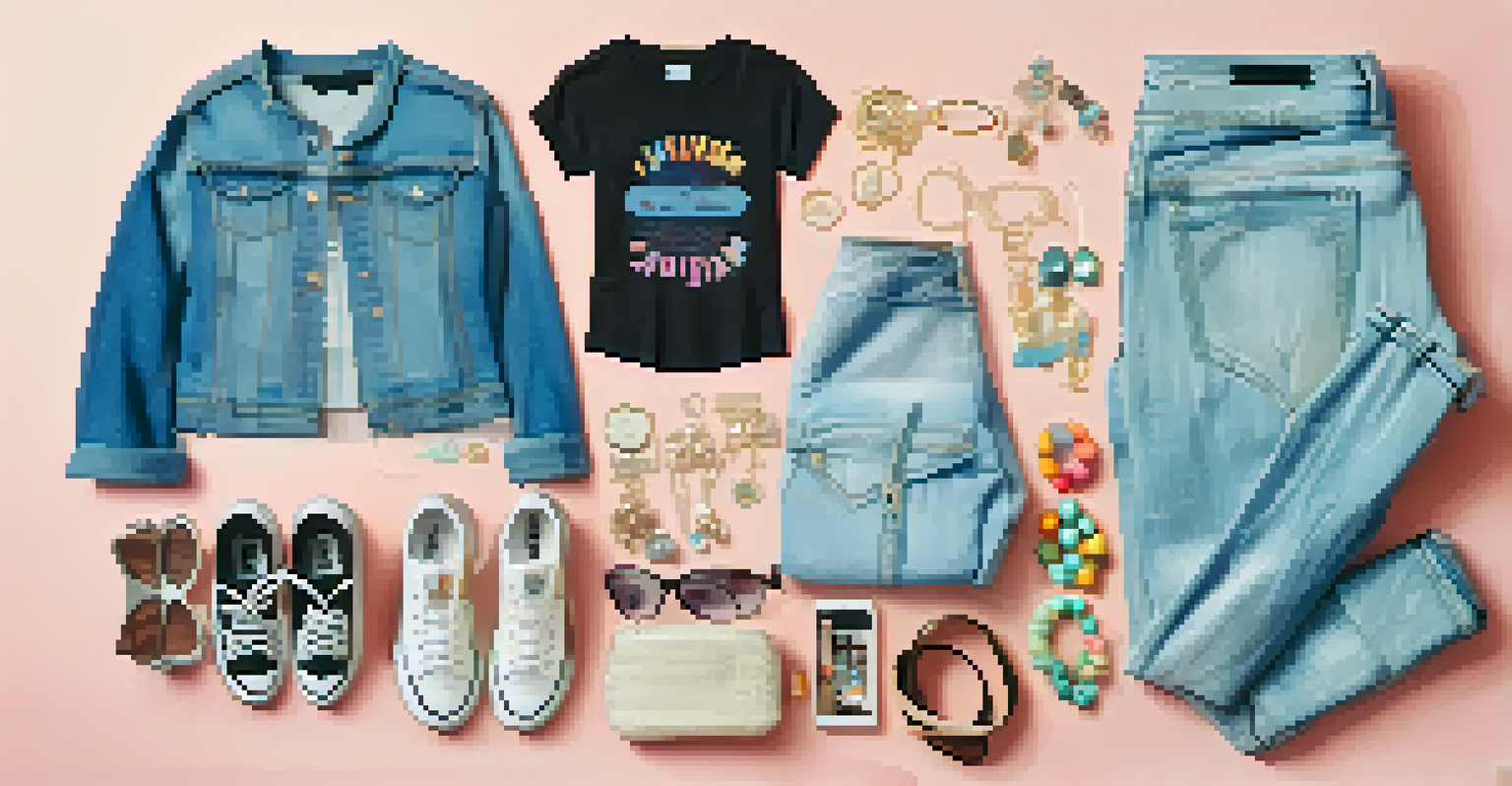2000s Fashion: Tech Influence and the Rise of Fast Fashion

The Digital Revolution: Fashion at the Click of a Button
The 2000s marked a turning point in how we accessed fashion, thanks to the rise of the internet. Online shopping became a staple for fashion enthusiasts, allowing them to browse endless collections from the comfort of their homes. This digital revolution made it easier than ever to discover new styles, designers, and trends, often with just a few clicks.
Fashion is the armor to survive the reality of everyday life.
With platforms like ASOS and eBay emerging, consumers could find unique pieces without stepping foot in a store. This accessibility not only broadened fashion choices but also encouraged people to experiment with their style, blending various influences from around the globe. Online communities began to flourish, fostering a culture of sharing and showcasing personal fashion statements.
As a result, fashion became more democratic, with everyone having the opportunity to participate in trends. This shift laid the groundwork for the fast fashion industry, which capitalized on the instant gratification that online shopping provided.
Fast Fashion: The New Era of Trend Accessibility
Fast fashion emerged in the 2000s as brands began to prioritize speed and affordability. Retailers like Zara and H&M became household names, churning out trendy pieces at breakneck speed to keep up with ever-changing consumer demands. This model allowed shoppers to buy the latest looks without breaking the bank, making fashion more accessible than ever.

However, the rapid production cycle raised questions about sustainability and ethics in the fashion industry. The allure of cheap clothing came with a hidden cost, as the environmental impact of mass production became increasingly evident. Many began to question whether sacrificing quality for quantity was worth it.
Online Shopping Transformed Fashion
The rise of the internet in the 2000s made fashion more accessible, allowing consumers to explore diverse styles and trends from home.
Despite these concerns, the fast fashion trend thrived, reflecting a society that valued immediacy and convenience. Shoppers became accustomed to frequent wardrobe updates, often discarding items after only a few wears, which led to a throwaway culture that still resonates today.
Celebrity Influence: From Red Carpets to Everyday Style
The 2000s were also defined by the influence of celebrities on fashion trends. Icons like Paris Hilton and Britney Spears became not just entertainers but also fashion trendsetters, inspiring fans to emulate their looks. The rise of reality television and social media further amplified their reach, making celebrity styles more accessible to the masses.
Sustainability is not a trend; it's a lifestyle.
Magazines and online platforms showcased these stars, creating a direct line between celebrity fashion and everyday wardrobes. This phenomenon led to a demand for similar styles, pushing fast fashion brands to create affordable replicas of high-profile outfits. It wasn't uncommon to see collections inspired by the latest red carpet looks hitting stores just days later.
As fans sought to replicate their favorite celebrities, the lines between high fashion and everyday wear blurred. This mixing of styles encouraged a more diverse approach to fashion, where anyone could channel their inner star with a trip to the local mall.
The Role of Technology: Changing How We Consume Fashion
Throughout the 2000s, technology played a pivotal role in how we consumed fashion. The advent of social media platforms like MySpace and later Facebook allowed users to share their outfits and style inspirations. This sharing culture fostered a sense of community among fashion lovers, leading to the birth of influential fashion bloggers and influencers.
With the rise of fashion blogs, consumers gained access to diverse perspectives and styles. These platforms not only showcased personal looks but also provided valuable tips on how to wear trends and mix high and low fashion. The democratization of fashion information shifted the power dynamic, allowing everyday people to influence trends.
Fast Fashion's Environmental Impact
While fast fashion made trendy clothing affordable, it also raised significant concerns about sustainability and the ethics of mass production.
Moreover, technology facilitated the rise of online fashion retailers, making it easier for shoppers to find the latest trends without ever leaving their homes. As consumers became more tech-savvy, their shopping habits evolved, creating a new norm in the fashion landscape.
Fashion Sustainability: The Growing Consciousness
As awareness of environmental issues grew, so did concern about the impact of fast fashion on the planet. The 2000s saw the beginnings of a shift toward sustainability, with consumers increasingly questioning the ethics behind their clothing choices. This burgeoning consciousness led to discussions about the need for more responsible fashion practices.
More brands began to prioritize sustainability, introducing eco-friendly materials and ethical production methods. Labels like Stella McCartney emerged, focusing on cruelty-free fashion and promoting a more mindful approach to consumerism. This movement encouraged shoppers to think critically about their purchases and the life cycle of their clothing.
While the fast fashion industry continued to thrive, the seeds of change were being sown. As consumers became more educated, they began to demand greater transparency and accountability from brands, setting the stage for a more sustainable future in fashion.
Subcultures and Their Fashion Statements in the 2000s
The 2000s were a rich tapestry of subcultures, each with its own distinct fashion identity. From the punk-inspired looks of emo kids to the laid-back style of skaters, these groups used fashion as a form of self-expression. This diversity in style highlighted the importance of individuality in a time when mass-market trends dominated.
Music played a significant role in shaping these subcultures, with artists influencing their fans' fashion choices. The influence of pop-punk bands, hip-hop artists, and indie musicians inspired young people to adopt styles that resonated with their tastes and beliefs. This connection between music and fashion created a vibrant scene where self-expression thrived.
Celebrity Culture Redefined Style
The influence of celebrities in the 2000s blurred the lines between high fashion and everyday wear, encouraging fans to emulate iconic looks.
As subcultures became more visible, mainstream fashion began to incorporate elements from these groups. The blending of styles led to a more eclectic approach, where elements of punk, hip-hop, and grunge could be found in everyday wardrobes, further emphasizing the importance of personal style.
The Legacy of 2000s Fashion: Lessons for Today
Looking back at the 2000s, it's clear that this era laid the groundwork for modern fashion trends. The influence of technology, fast fashion, and celebrity culture reshaped how we view style and consumption. While some aspects of that time may be seen as superficial, they also sparked important conversations about sustainability and individuality.
Today's fashion landscape still grapples with many of the issues that arose in the 2000s, such as the impact of fast fashion on the environment. However, the lessons learned from this era have prompted a shift toward more sustainable practices and a focus on ethical consumption. Consumers are now more empowered to make informed choices about their clothing.

Ultimately, the legacy of 2000s fashion serves as a reminder of the power of style and its ability to reflect societal changes. By embracing both the creativity and the challenges of this era, we can navigate the future of fashion with a more conscious perspective.